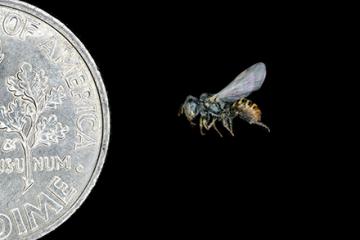Specialized Bees Power Desert Ecosystems

Mojave poppy bee (Perdita meconis). (Photo by Michael Branstetter, D5160-1)
Deserts may seem barren and lifeless, but, in fact, the deserts of the American Southwest boast a wide range of ecosystems that depend on the pollinating power of bees. Very specialized bees.
“Several of the ecosystems with the highest diversity of species of bees are in the Southwestern United States,” said Diana Cox-Foster, research leader at the ARS Pollinating Insect-Biology, Management, Systematics Research Unit (PIRU) in Logan, UT. “Incredibly, deserts in this part of the country can have a high number of bee species, even in the driest areas.”
According to Cox-Foster, the desert areas have a rich mixture of micro-ecosystems, such as desert springs and areas shielded by canyons, and these micro-ecosystems contain a wide diversity in plant species. Those plants include many that are important to tribal groups and others as food and medicinal plants or are culturally important. Understanding the pollinators that are in the desert helps link them to pollinating these crops.
“In the desert southwest, there are tribal groups and others who grow crops using methods adapted for areas with restricted precipitation and desert weather cycles. One such cropping system is the ‘three sisters,’ or corn/beans/squash,” Cox-Foster explained. “Beans benefit from pollination, with squash being solely dependent upon pollination. The squash bees and others are excellent pollinators of squash.”

Mojave poppy bee (Perdita meconis) with size compared to a dime. (Photo by Chelsey Ritner, D5161-1)
Bee species that live in the harsh desert conditions use physiological adaptations to survive with very limited water and high temperatures. One such bee, the Mojave Poppy Bee (Perdita meconis), can even put itself into a type of suspended animation – called “bet hedging” – until there is enough water available for them to mature. During multiple years of extreme drought, this native of southern Nevada is rarely found pollinating the Las Vegas poppy, but with increased rainfall and abundant desert bloom, the bees once again appear in larger numbers.
Understanding how these bees can thrive in harsh environments may enable scientists to help other pollinators – like the honeybee – avoid population declines and adapt to climatic extremes. Researchers at PIRU are analyzing bee DNA sequences that may enable them to answer many pressing questions about bee biology, understand their health, and provide insight into the diseases they face.
Mapping the bees’ genetic sequences can also reveal how diverse the populations are and how related they are to bees from other regions. Some plant/pollinator relationships have become quite specialized, with a plant pollinated by a specific bee species, which visits only that flowering plant. Cox-Foster noted that higher genetic diversity is indicative of healthier populations and healthier environments.
“Our research goal is to gather data that will help guide policies to ensure a healthy pollinator community,” she said. “Having a healthy pollinator community will benefit the agricultural production of crops that provide vegetables, fruits, and nuts for food and healthy ecosystems. – by Scott Elliott, ARS Office of Communications.
You May Also Like:

